Adaptive Control Approach for Accurate Current Sharing and Voltage Regulation in DC Microgrid Applications
Abstract
1. Introduction
- Investigating the primary challenges with the parallel DC-DC converters of classic droop control in DC microgrids;
- Parallel DC-DC converter design and management for stand-alone application;
- A simple and adaptive droop control solution is proposed to eliminate bus voltage variation and circulating current between converters with equal load current sharing.
- Effectively maintains power balance in the microgrid under major disturbances;
- Accurately regulates DC bus voltages under diverse operational situations and increases electricity sharing;
- Increases the stability of the DC microgrid and its dynamic response to disturbances;
- Improves DC microgrid dependability, flexibility, modularity, and scalability.
2. Materials and Methods
2.1. Buck DC-DC Converter Configuration System in a DC Microgrid
2.2. Formatting of Mathematical Components
2.3. Conventional Droop Control
2.4. Adaptive Droop Control in DC Microgrid Strategy
2.5. Primary Control Loop System
2.6. Secondary Control Loop System
3. Results
Comparison of Two Strategies
4. Discussion
5. Conclusions
Author Contributions
Funding
Data Availability Statement
Conflicts of Interest
References
- Mumtaz, F.; Yahaya, N.Z.; Meraj, S.T.; Singh, B.; Kannan, R.; Ibrahim, O. Review on non-isolated DC-DC converters and their control techniques for renewable energy applications. Ain Shams Eng. J. 2021, 12, 3747–3763. [Google Scholar] [CrossRef]
- Alam, S.; Al-Ismail, F.S.; Rahman, S.M.; Shafiullah; Hossain, A. Planning and protection of DC microgrid: A critical review on recent developments. Eng. Sci. Technol. Int. J. 2023, 41, 101404. [Google Scholar] [CrossRef]
- Srinivasan, M.; Kwasinski, A. Control analysis of parallel DC-DC converters in a DC microgrid with constant power loads. Int. J. Electr. Power Energy Syst. 2020, 122, 106207. [Google Scholar] [CrossRef]
- Qin, Y.; Yang, Y.; Li, S.; Huang, Y.; Tan, S.-C.; Hui, S.Y. A High-Efficiency DC/DC Converter for High-Voltage-Gain, High-Current Applications. IEEE J. Emerg. Sel. Top. Power Electron. 2019, 8, 2812–2823. [Google Scholar] [CrossRef]
- Baranwal, M.; Askarian, A.; Salapaka, S.; Salapaka, M. A Distributed Architecture for Robust and Optimal Control of DC Microgrids. IEEE Trans. Ind. Electron. 2018, 66, 3082–3092. [Google Scholar] [CrossRef]
- Bharath, K.R.; Krishnan, M.M.; Kanakasabapathy, P. A Review on DC Microgrid Control Techniques, Applications and Trends. Int. J. Renew. Energy Res. 2019, 9, 1328–1338. [Google Scholar] [CrossRef]
- Dahale, S.; Das, A.; Pindoriya, N.M.; Rajendran, S. An overview of DC-DC converter topologies and controls in DC microgrid. In Proceedings of the 2017 7th International Conference on Power Systems (ICPS), Pune, India, 21–23 December 2017; pp. 410–415. [Google Scholar]
- Silva, W.W.A.G.; Oliveira, T.R.; Donoso-Garcia, P.F. An Improved Voltage-Shifting Strategy to Attain Concomitant Accurate Power Sharing and Voltage Restoration in Droop-Controlled DC Microgrids. IEEE Trans. Power Electron. 2020, 36, 2396–2406. [Google Scholar] [CrossRef]
- Ghanbari, N.; Bhattacharya, S. Adaptive Droop Control Method for Suppressing Circulating Currents in DC Microgrids. IEEE Open Access J. Power Energy 2020, 7, 100–110. [Google Scholar] [CrossRef]
- He, W.; Namazi, M.M.; Koofigar, H.R.; Amirian, M.A.; Guerrero, J.M. Voltage regulation of buck converter with constant power load: An adaptive power shaping control. Control. Eng. Pract. 2021, 115, 104891. [Google Scholar] [CrossRef]
- Yuan, M.; Fu, Y.; Mi, Y.; Li, Z.; Wang, C. Hierarchical control of DC microgrid with dynamical load power sharing. Appl. Energy 2019, 239, 1–11. [Google Scholar] [CrossRef]
- Ahmed, S.; Kashif, S.A.R.; Ain, N.U.; Rasool, A.; Shahid, M.S.; Padmanaban, S.; Ozsoy, E.; Saqib, M.A. Mitigation of Complex Non-Linear Dynamic Effects in Multiple Output Cascaded DC-DC Converters. IEEE Access 2021, 9, 54602–54612. [Google Scholar] [CrossRef]
- Mohammadi, J.; Ajaei, F.B. Improved Mode-Adaptive Droop Control Strategy for the DC Microgrid. IEEE Access 2019, 7, 86421–86435. [Google Scholar] [CrossRef]
- Muchande, S.; Thale, S. Design and Implementation of Autonomous Low Voltage DC Microgrid with Hierarchical Control. In Proceedings of the 2020 IEEE First International Conference on Smart Technologies for Power, Energy and Control (STPEC), Nagpur, India, 25–26 September 2020; pp. 1–6. [Google Scholar]
- Hamed, S.B.; Ben Hamed, M.; Sbita, L. Robust Voltage Control of a Buck DC-DC Converter: A Sliding Mode Approach. Energies 2022, 15, 6128. [Google Scholar] [CrossRef]
- Reddy, P.K.G.; Dasarathan, S.; Krishnasamy, V. Investigation of Adaptive Droop Control Applied to Low-Voltage DC Microgrid. Energies 2021, 14, 5356. [Google Scholar] [CrossRef]
- Cheng, Z.; Li, Z.; Li, S.; Gao, J.; Si, J.; Das, H.S.; Dong, W. A novel cascaded control to improve stability and inertia of parallel buck-boost converters in DC microgrid. Int. J. Electr. Power Energy Syst. 2020, 119, 105950. [Google Scholar] [CrossRef]
- Liu, Y.; Zhuang, X.; Zhang, Q.; Arslan, M.; Guo, H. A novel droop control method based on virtual frequency in DC microgrid. Int. J. Electr. Power Energy Syst. 2020, 119, 105946. [Google Scholar] [CrossRef]
- Bhosale, R.; Gupta, R.; Agarwal, V. A Novel Control Strategy to Achieve SOC Balancing for Batteries in a DC Microgrid Without Droop Control. IEEE Trans. Ind. Appl. 2021, 57, 4196–4206. [Google Scholar] [CrossRef]
- Jiang, Y.; Yang, Y.; Tan, S.-C.; Hui, S.-Y.R. Distribution Power Loss Mitigation of Parallel-Connected Distributed Energy Resources in Low-Voltage DC Microgrids Using a Lagrange Multiplier-Based Adaptive Droop Control. IEEE Trans. Power Electron. 2021, 36, 9105–9118. [Google Scholar] [CrossRef]
- Liu, H.; Guo, W.; Cheng, D.; Wang, Y.; Wang, M. Stability and Bifurcation Analysis of DC Microgrid with Multiple Droop Control Sources and Loads. IEEE Trans. Power Electron. 2020, 36, 2361–2372. [Google Scholar] [CrossRef]
- Peyghami, S.; Davari, P.; Mokhtari, H.; Blaabjerg, F. Decentralized Droop Control in DC Microgrids Based on a Frequency Injection Approach. IEEE Trans. Smart Grid 2019, 10, 6782–6791. [Google Scholar] [CrossRef]
- Ingle, A.; Shyam, A.B.; Sahoo, S.R.; Anand, S. Quality-Index Based Distributed Secondary Controller for a Low-Voltage DC Microgrid. IEEE Trans. Ind. Electron. 2018, 65, 7004–7014. [Google Scholar] [CrossRef]
- Gao, F.; Kang, R.; Cao, J.; Yang, T. Primary and secondary control in DC microgrids: A review. J. Mod. Power Syst. Clean Energy 2018, 7, 227–242. [Google Scholar] [CrossRef]
- Mossa, M.A.; Gam, O.; Bianchi, N.; Quynh, N.V. Enhanced Control and Power Management for a Renewable Energy-Based Water Pumping System. IEEE Access 2022, 10, 36028–36056. [Google Scholar] [CrossRef]
- Kreiss, J.; Bodson, M.; Delpoux, R.; Gauthier, J.-Y.; Trégouët, J.-F.; Lin-Shi, X. Optimal control allocation for the parallel interconnection of buck converters. Control. Eng. Pract. 2021, 109, 104727. [Google Scholar] [CrossRef]
- Roslan, M.; Hannan, M.; Ker, P.J.; Uddin, M. Microgrid control methods toward achieving sustainable energy management. Appl. Energy 2019, 240, 583–607. [Google Scholar] [CrossRef]
- Zhang, Y.; Qu, X.; Tang, M.; Yao, R.; Chen, W. Design of Nonlinear Droop Control in DC Microgrid for Desired Voltage Regulation and Current Sharing Accuracy. IEEE J. Emerg. Sel. Top. Circuits Syst. 2021, 11, 168–175. [Google Scholar] [CrossRef]
- Al-Ismail, F.S. DC Microgrid Planning, Operation, and Control: A Comprehensive Review. IEEE Access 2021, 9, 36154–36172. [Google Scholar] [CrossRef]
- Kreishan, M.Z.; Zobaa, A.F. Optimal Allocation and Operation of Droop-Controlled Islanded Microgrids: A Review. Energies 2021, 14, 4653. [Google Scholar] [CrossRef]
- Xie, W.; Han, M.; Cao, W.; Guerrero, J.M.; Vasquez, J.C. System-Level Large-Signal Stability Analysis of Droop-Controlled DC Microgrids. IEEE Trans. Power Electron. 2020, 36, 4224–4236. [Google Scholar] [CrossRef]
- Sayed, K.; Abdel-Khalek, S.; Zakaly, H.M.H.; Aref, M. Energy Management and Control in Multiple Storage Energy Units (Battery–Supercapacitor) of Fuel Cell Electric Vehicles. Materials 2022, 15, 8932. [Google Scholar] [CrossRef]
- Poursafar, N.; Taghizadeh, S.; Hossain, M.; Blaabjerg, F. An enhanced control strategy for an ultra-fast EV charging station in a DC microgrid. Int. J. Electr. Power Energy Syst. 2023, 146, 108727. [Google Scholar] [CrossRef]
- Seth, A.K.; Singh, M. Unified adaptive neuro-fuzzy inference system control for OFF board electric vehicle charger. Int. J. Electr. Power Energy Syst. 2021, 130, 106896. [Google Scholar] [CrossRef]
- Macharia, V.M.; Garg, V.K.; Kumar, D. A review of electric vehicle technology: Architectures, battery technology and its management system, relevant standards, application of artificial intelligence, cyber security, and interoperability challenges. IET Electr. Syst. Transp. 2023, 13, e12083. [Google Scholar] [CrossRef]
- Ferahtia, S.; Djerioui, A.; Rezk, H.; Chouder, A.; Houari, A.; Machmoum, M. Adaptive Droop based Control Strategy for DC Microgrid Including Multiple Batteries Energy Storage Systems. J. Energy Storage 2022, 48, 103983. [Google Scholar] [CrossRef]



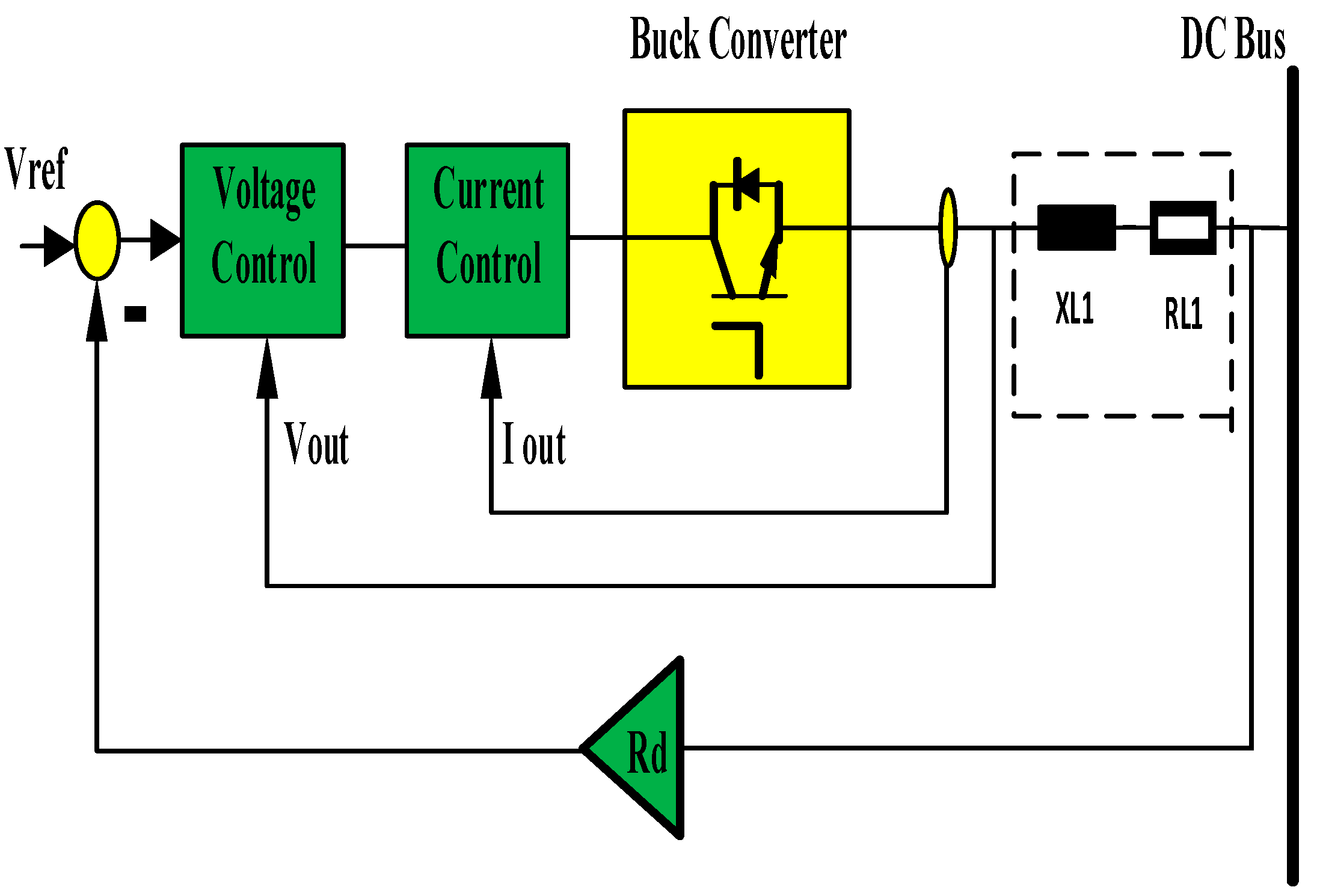
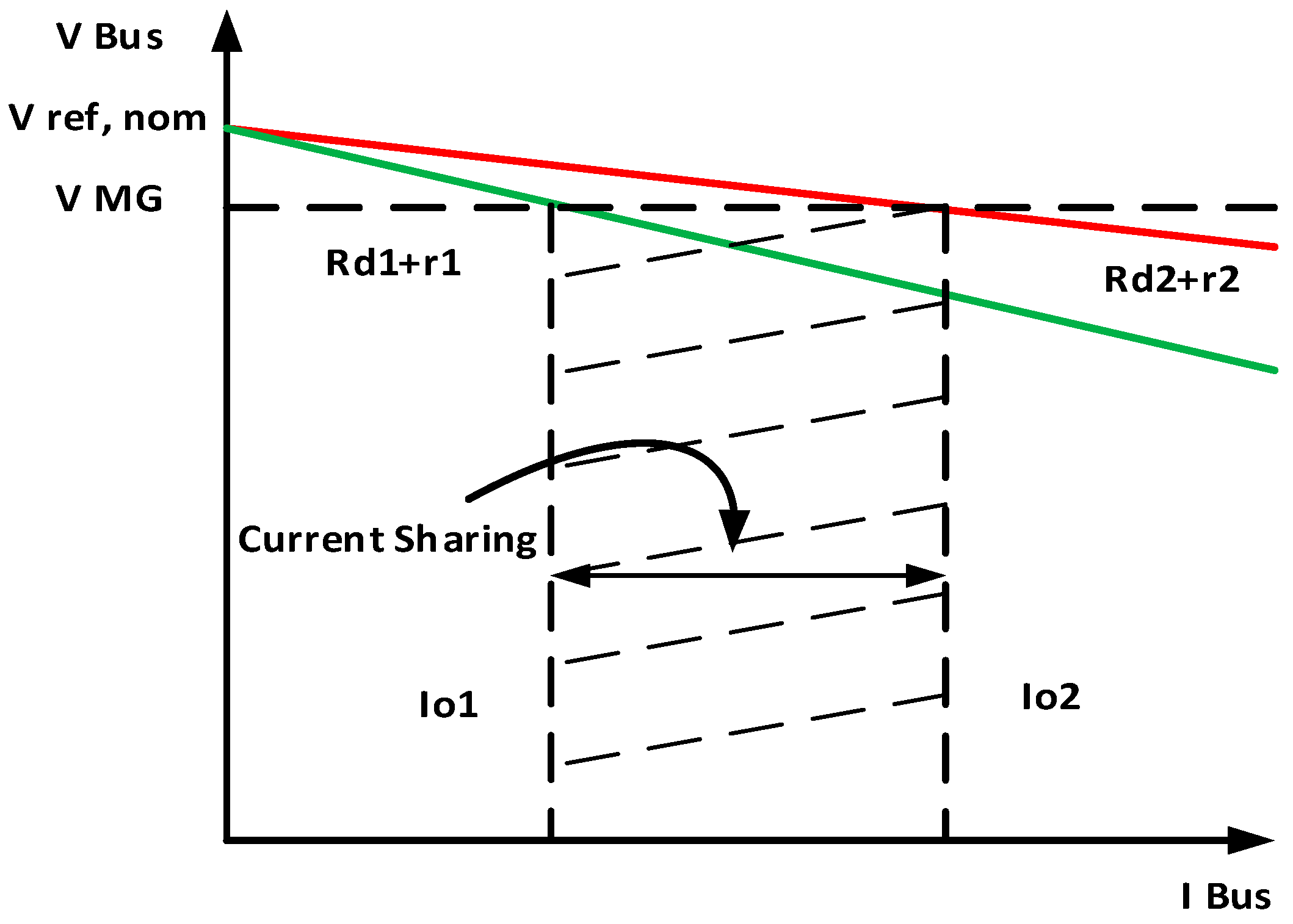
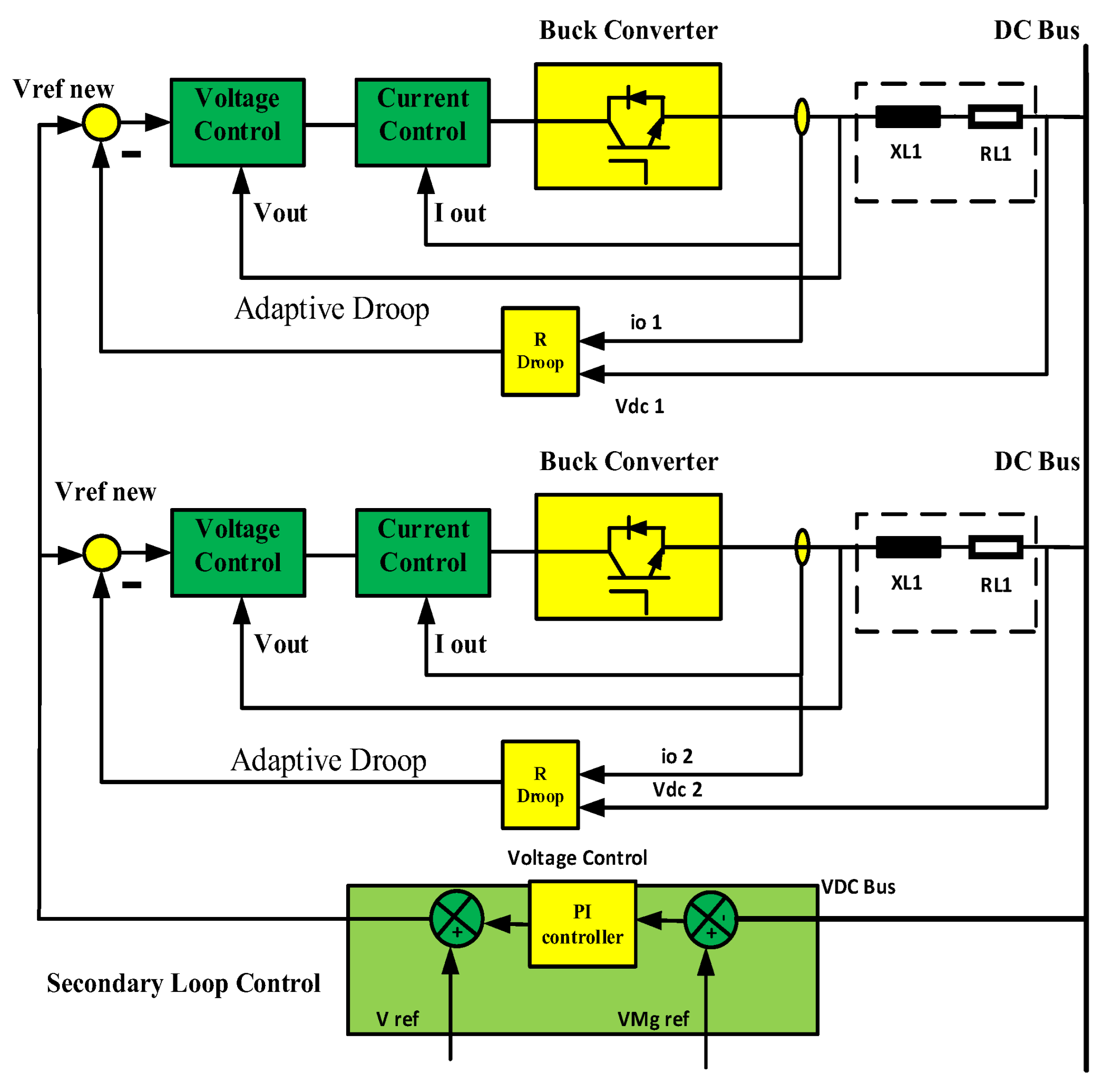
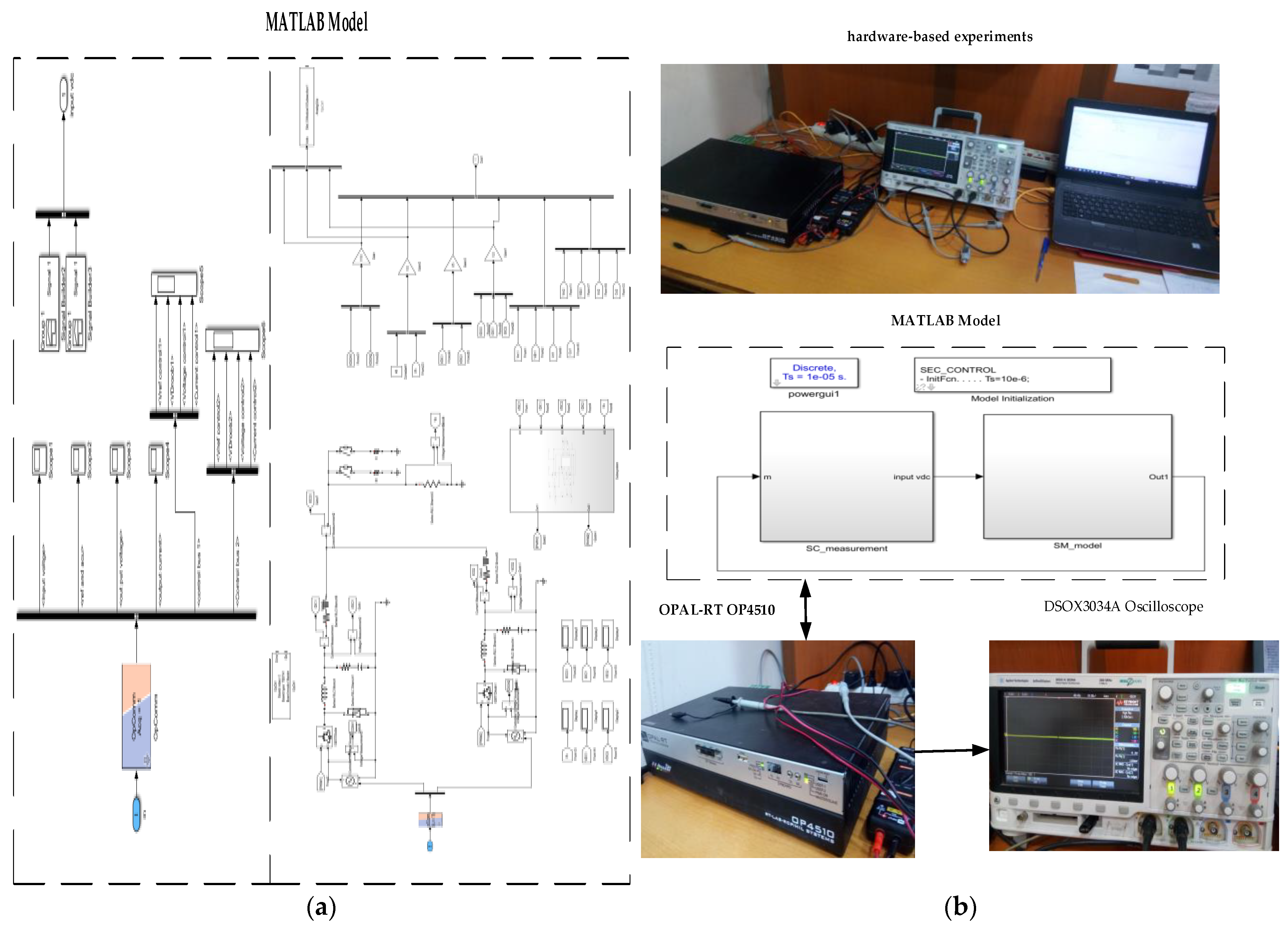


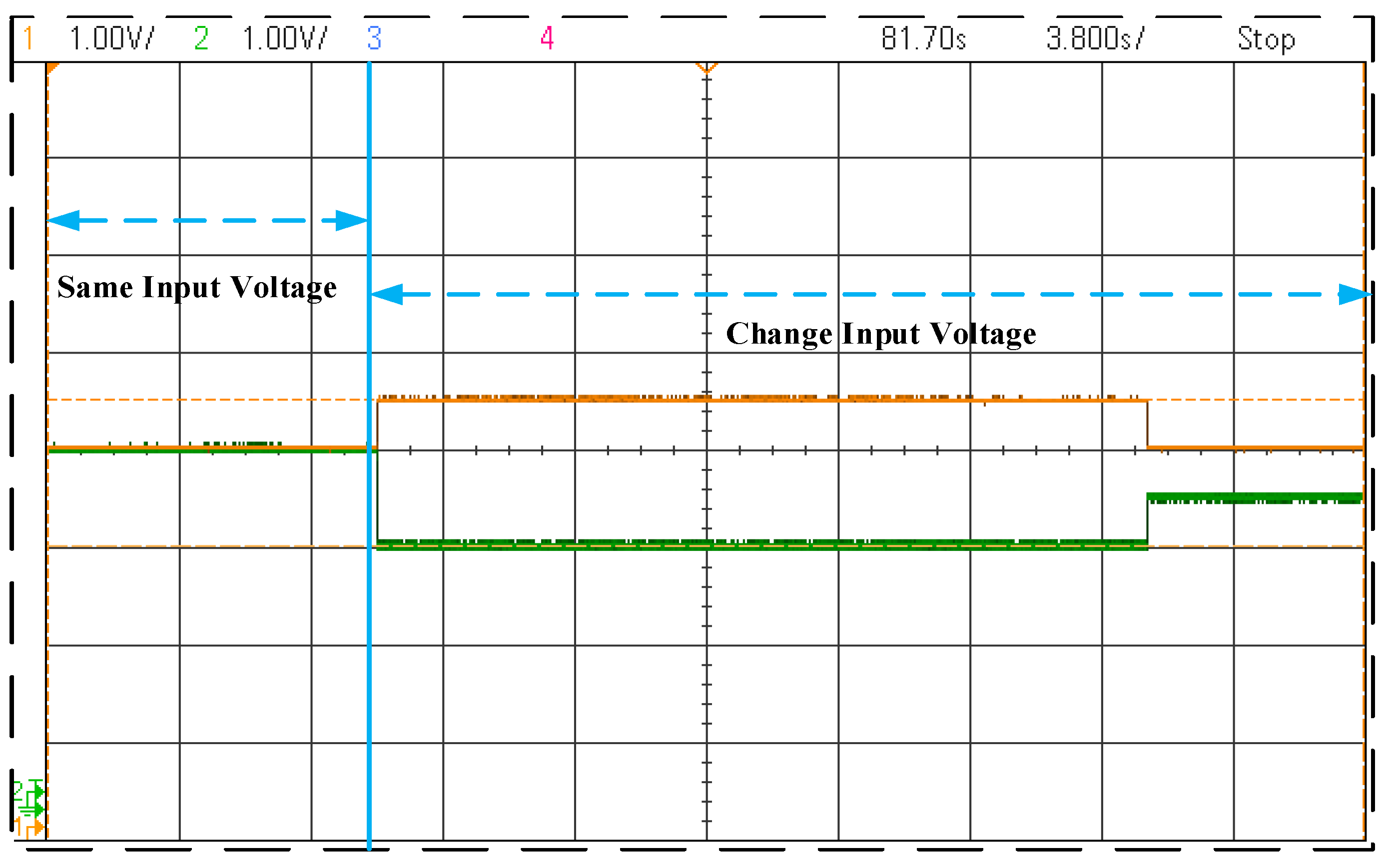

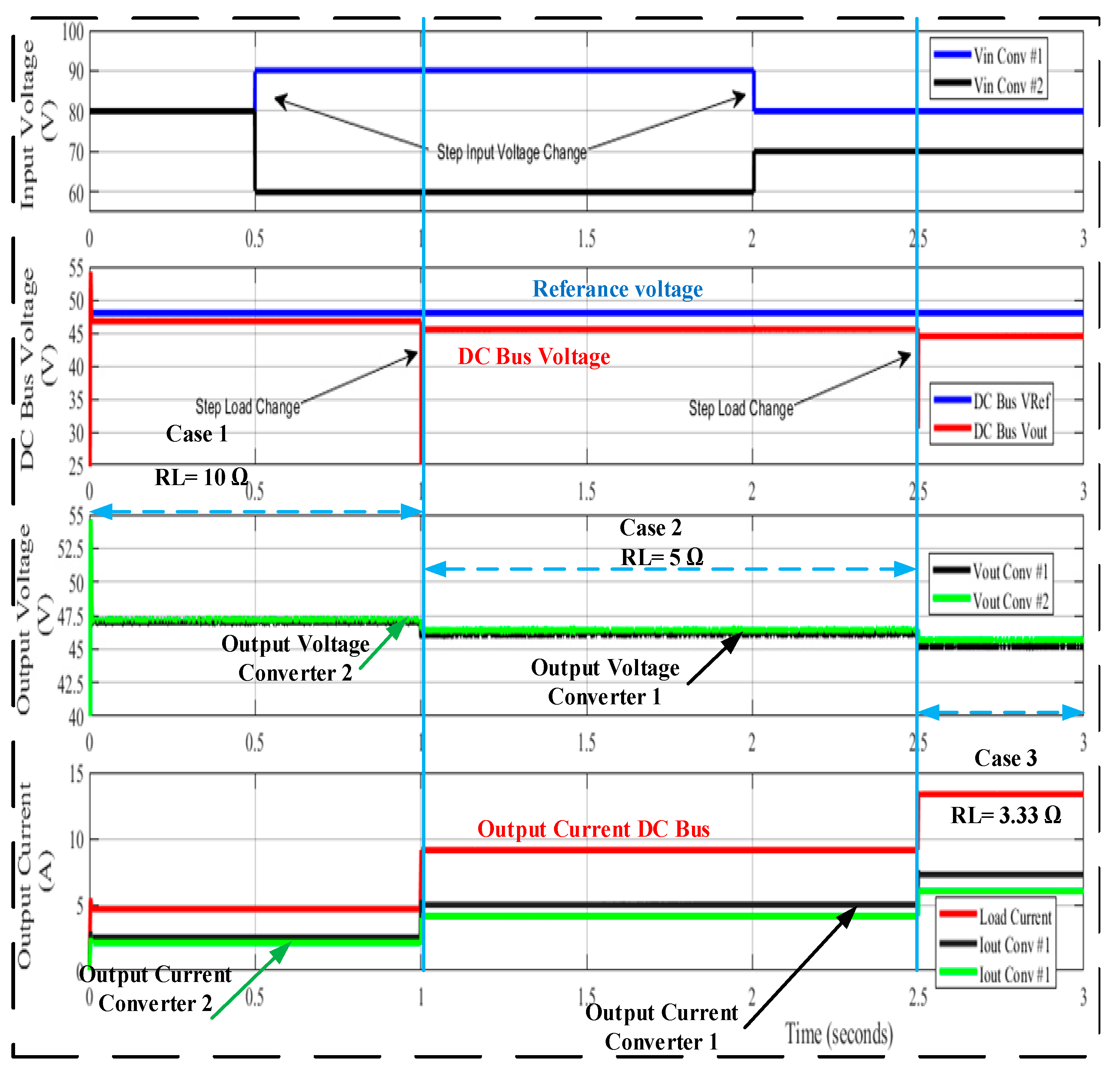

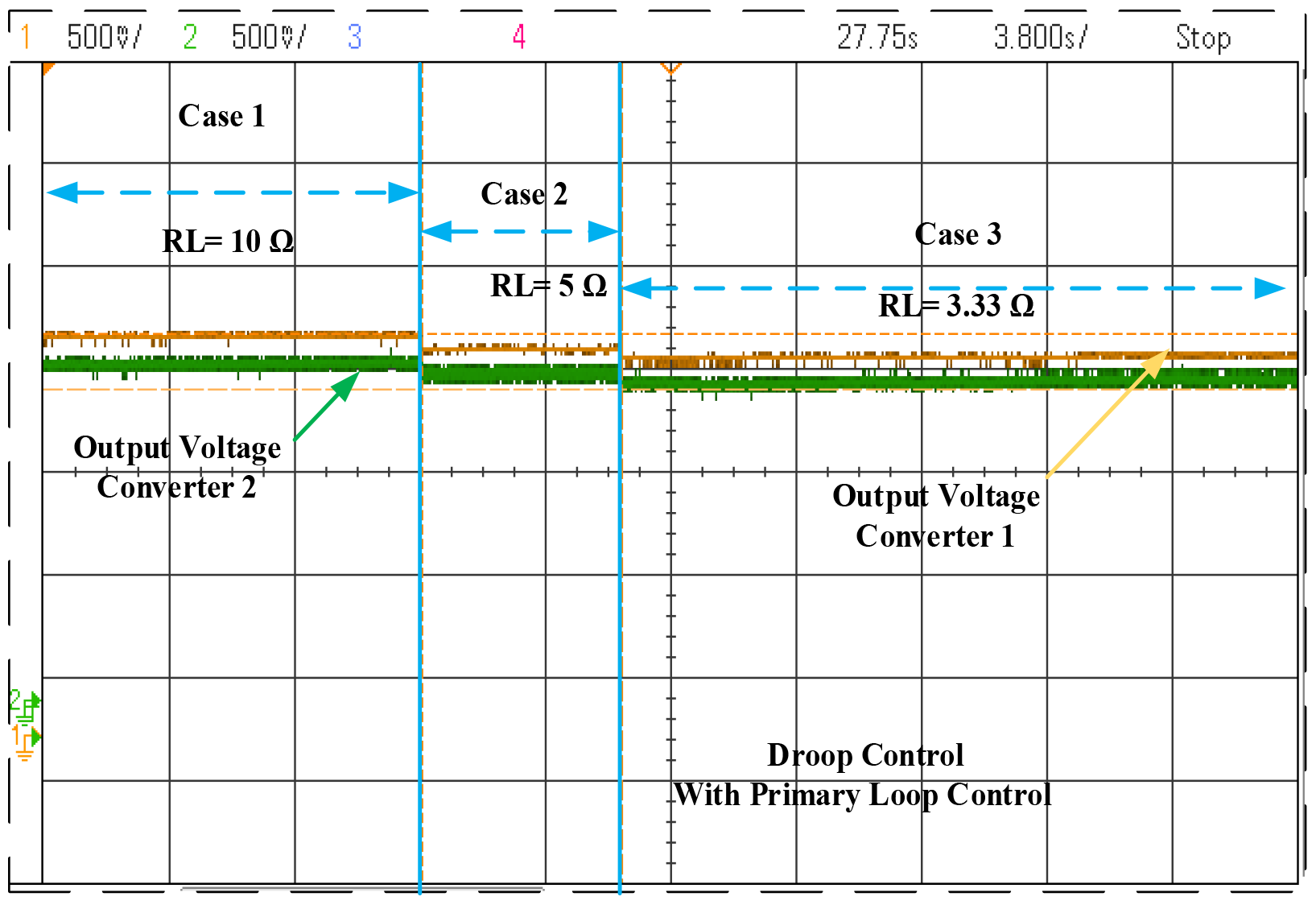
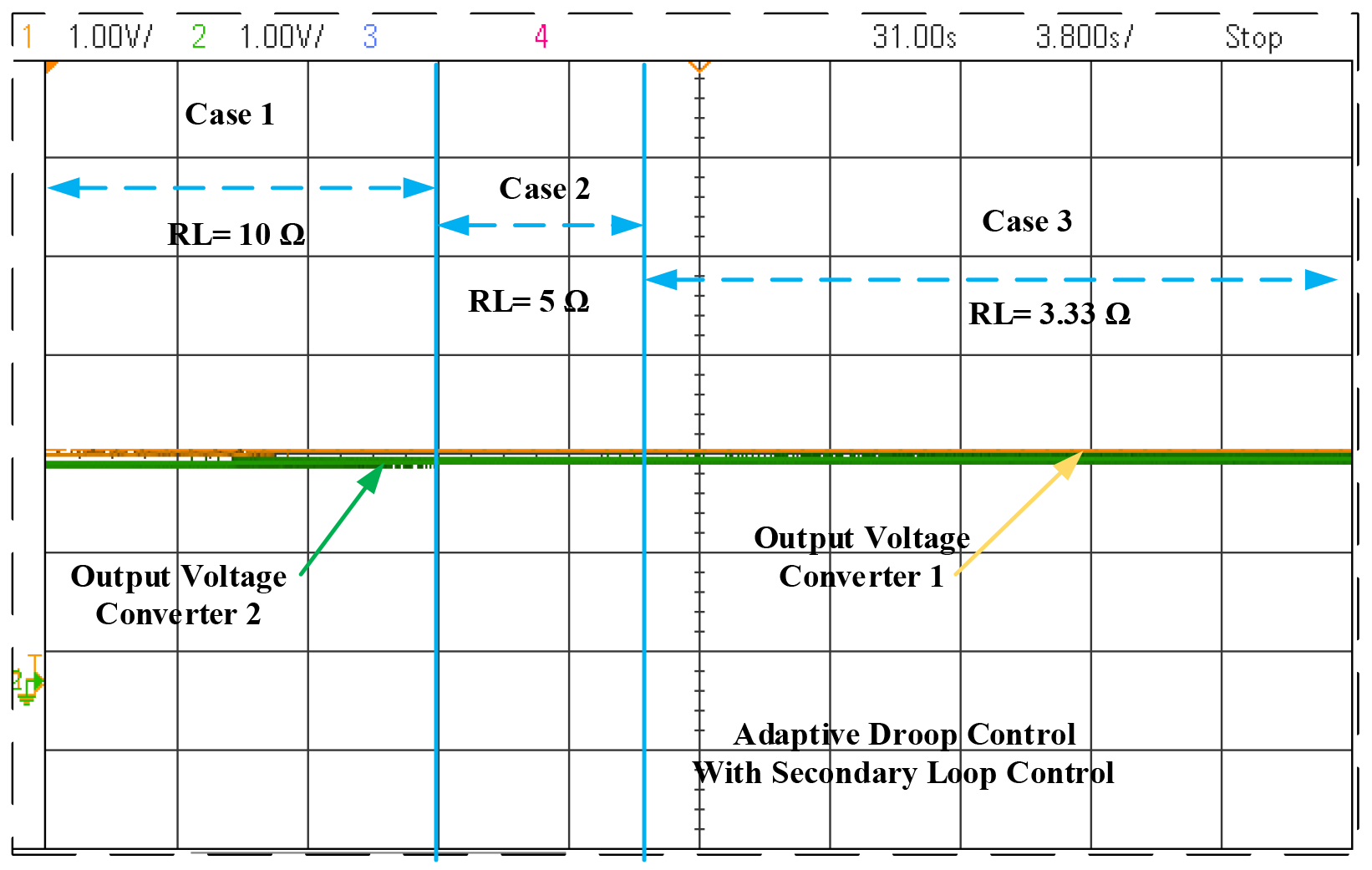
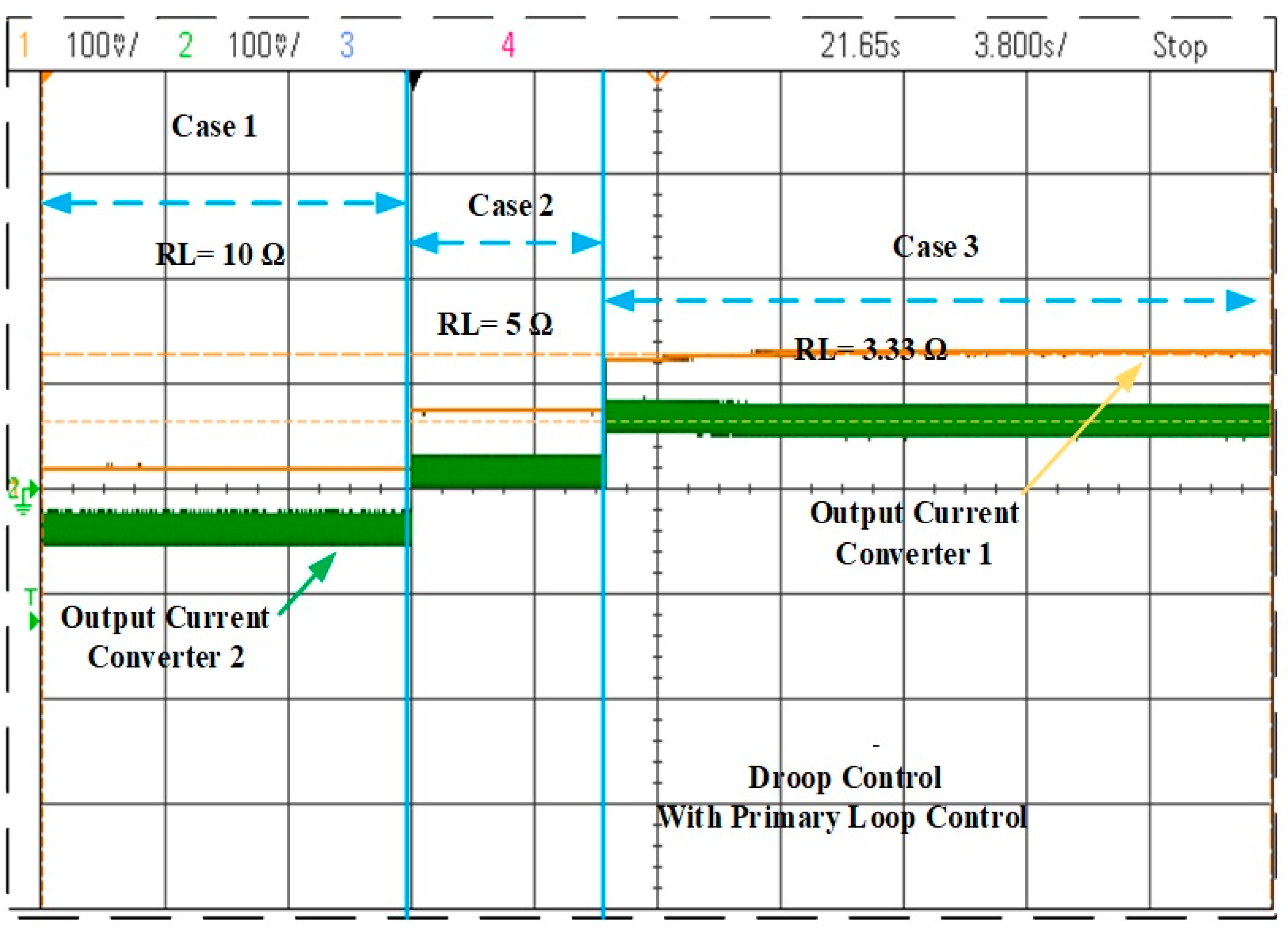

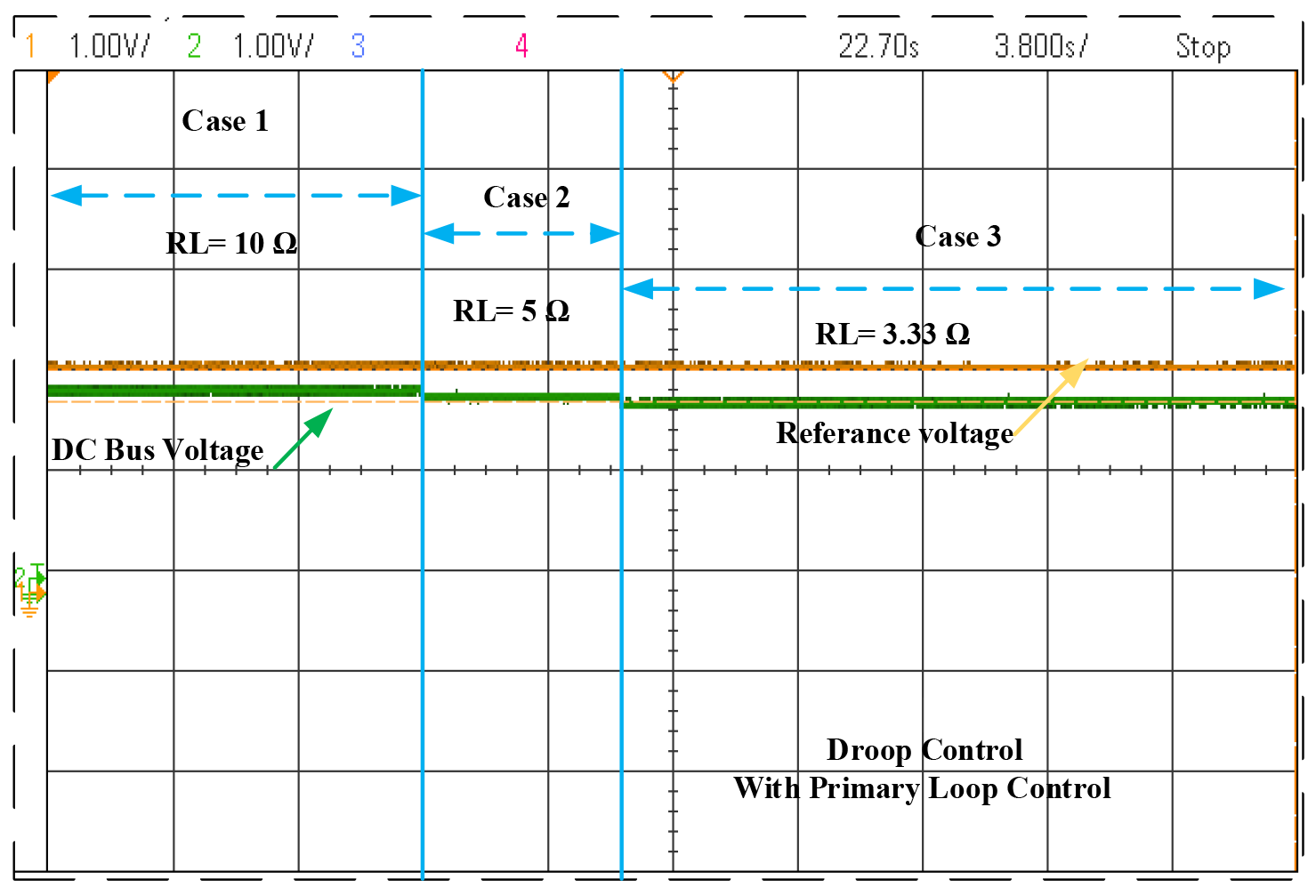


| Parameters | Symbol | Values |
|---|---|---|
| Ideal voltage DC bus | VDC | 48 V |
| Current rating for source | I rated | 20 A |
| Resistance of line-1 | R1 | 0.1 Ω |
| Resistance of line-2 | R2 | 0.2 Ω |
| Inductance of cable line-1 | L1 | 0.2 mH |
| Inductance of cable line-2 | L2 | 0.4 mH |
| Resistance of capacitor 1 | rc1 | 0.03 Ω |
| Resistance of capacitor 2 | rc2 | 0.03 Ω |
| Method | V Bus (V) | I Bus (I1, I2) (A) | I Circulate % | V Bus % |
|---|---|---|---|---|
| Droop gain with primary control | 46.73 | 4.674 (2.55, 2.124) | 9.11 | 2.65 |
| Adaptive droop gain with secondary control | 47.77 | 4.777 (2.511, 2.266) | 5.13 | 0.48 |
| Method | V Bus (V) | I Bus (I1, I2) (A) | I Circulate % | V Bus % |
|---|---|---|---|---|
| Droop gain with primary control | 45.56 | 9.108 (4.975, 4.132) | 9.25 | 5.08 |
| Adaptive droop gain with secondary control | 47.55 | 9.509 (4.851, 4.657) | 2.04 | 0.94 |
| Method | V Bus (V) | I Bus (I1, I2) (A) | I Circulate % | V Bus % |
|---|---|---|---|---|
| Droop gain with primary control | 44.45 | 13.33 (7.282, 6.044) | 9.29 | 7.4 |
| Adaptive droop gain with secondary control | 47.38 | 14.21 (7.157, 7.055) | 0.72 | 1.29 |
| Case | Input Voltages Vi1–Vi2 | Cable Resistances R1–R2 | Output Voltages V1–V2 | Output Currents I1–I2 |
|---|---|---|---|---|
| 1 | Equal | Equal | Equal | Equal |
| 2 | Equal | Unequal | Equal | Unequal |
| 3 | Unequal | Equal | Unequal | Unequal |
| 4 | Unequal | Unequal | Unequal | Unequal |
Disclaimer/Publisher’s Note: The statements, opinions and data contained in all publications are solely those of the individual author(s) and contributor(s) and not of MDPI and/or the editor(s). MDPI and/or the editor(s) disclaim responsibility for any injury to people or property resulting from any ideas, methods, instructions or products referred to in the content. |
© 2024 by the authors. Licensee MDPI, Basel, Switzerland. This article is an open access article distributed under the terms and conditions of the Creative Commons Attribution (CC BY) license (https://creativecommons.org/licenses/by/4.0/).
Share and Cite
Mesbah, M.A.; Sayed, K.; Ahmed, A.; Aref, M.; Elbarbary, Z.M.S.; Almuflih, A.S.; Mossa, M.A. Adaptive Control Approach for Accurate Current Sharing and Voltage Regulation in DC Microgrid Applications. Energies 2024, 17, 284. https://doi.org/10.3390/en17020284
Mesbah MA, Sayed K, Ahmed A, Aref M, Elbarbary ZMS, Almuflih AS, Mossa MA. Adaptive Control Approach for Accurate Current Sharing and Voltage Regulation in DC Microgrid Applications. Energies. 2024; 17(2):284. https://doi.org/10.3390/en17020284
Chicago/Turabian StyleMesbah, Mohamed A., Khairy Sayed, Adel Ahmed, Mahmoud Aref, Z. M. S. Elbarbary, Ali Saeed Almuflih, and Mahmoud A. Mossa. 2024. "Adaptive Control Approach for Accurate Current Sharing and Voltage Regulation in DC Microgrid Applications" Energies 17, no. 2: 284. https://doi.org/10.3390/en17020284
APA StyleMesbah, M. A., Sayed, K., Ahmed, A., Aref, M., Elbarbary, Z. M. S., Almuflih, A. S., & Mossa, M. A. (2024). Adaptive Control Approach for Accurate Current Sharing and Voltage Regulation in DC Microgrid Applications. Energies, 17(2), 284. https://doi.org/10.3390/en17020284










